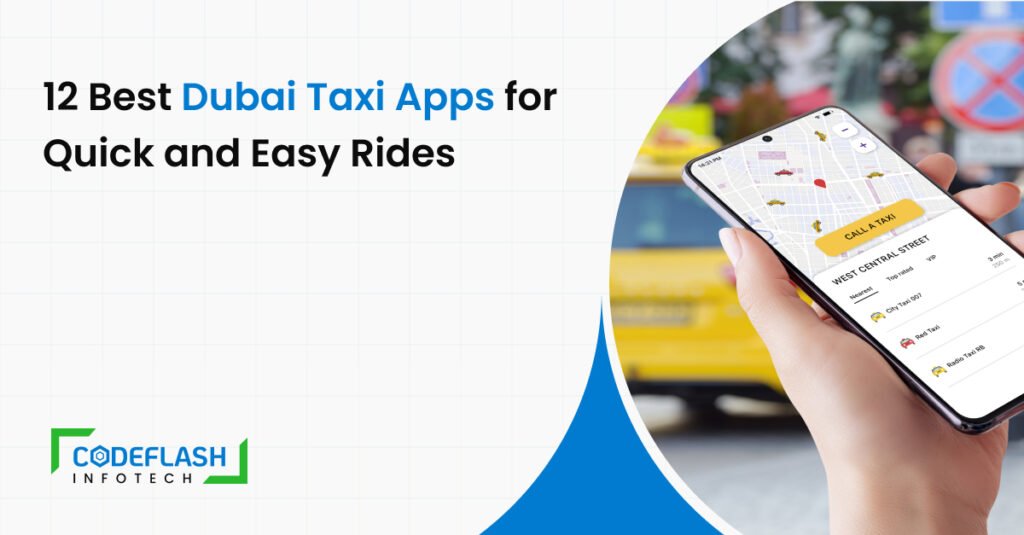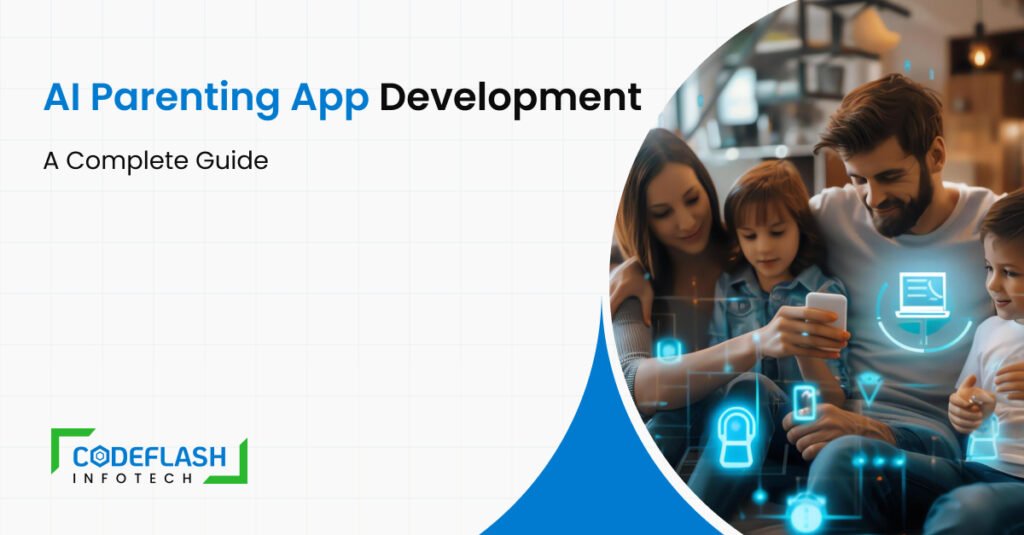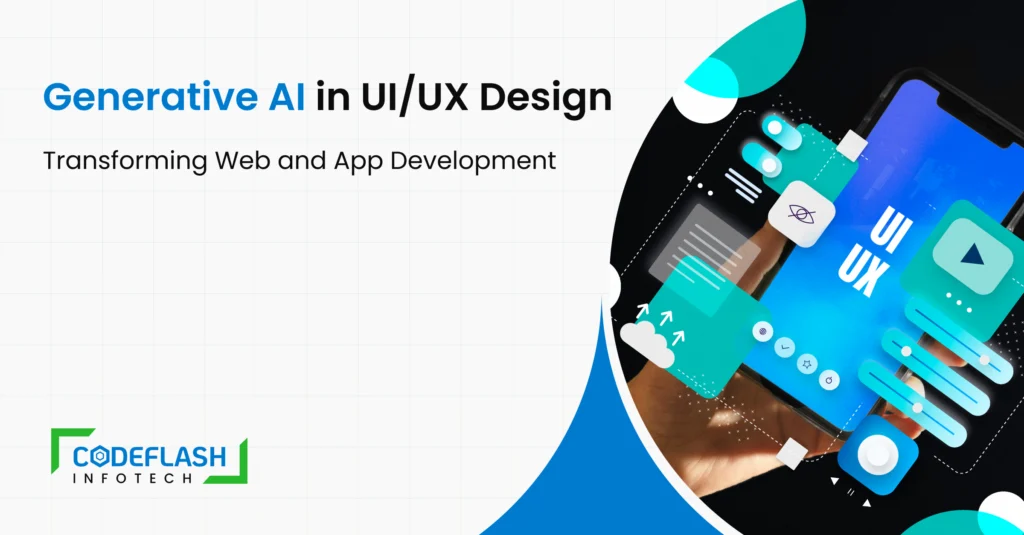
Generative AI in UI/UX Design: Transforming Web and App Development
02 SEPTEMBER
People’s expectations of the digital View are changing at a rapid rate. Users form their first impression in less than one second, and so having an engaging and intuitive UI/UX design is no longer a “nice to have”; it’s an expectation!
The global UX services market size was valued at USD 4.68 billion in 2024. The market is projected to grow from USD 6.40 billion in 2025 to USD 54.93 billion by 2032, exhibiting a CAGR of 36% during the forecast period. North America dominated the global ux services market with a share of 33.55% in 2024. Additionally, the U.S. UX services market is projected to grow significantly, reaching an estimated value of USD 12,170.2 million by 2032.
It has always taken a long time to create user-centred designs using user research, A/B testing, and iterations. Generative AI UI UX design is affecting this model. AI is more than just a helper. AI is becoming a co-designer in everything from automated layout creation to user-predictive flows.
Generative AI is a Game Changer
Generative AI builds machine learning models that generate creative outputs, including design elements. Programs like Adobe Firefly and Figma AI are just starting to cause a stir around how quickly and easily designers can take a concept and evolve it to a wireframe in seconds.
AI-powered UI/UX design accelerates prototyping cycles, simplifies decision-making, and reduces human error. This is ideal for startups requiring rapid MVPs and businesses seeking scalable design systems.
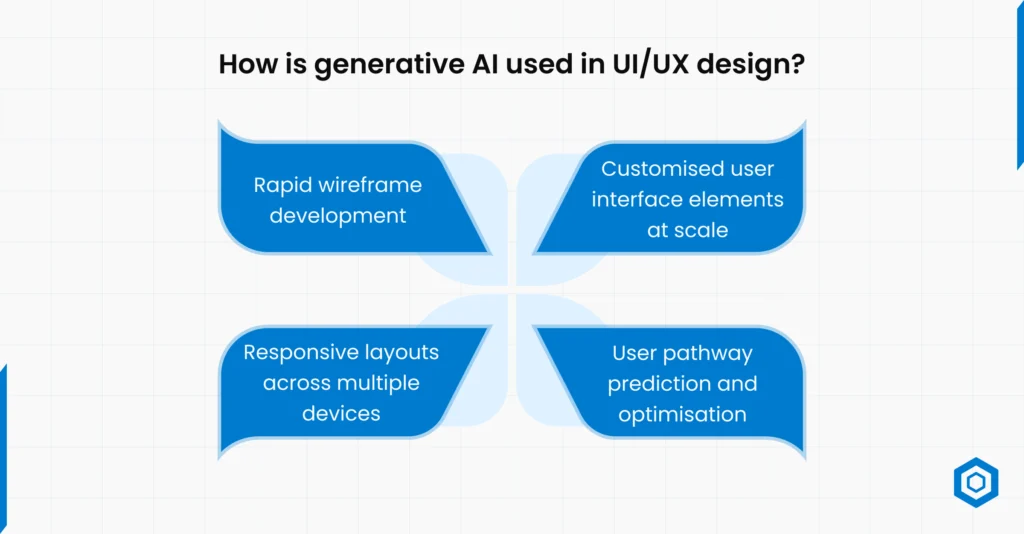
How is generative AI used in UI/UX design?
- Rapid Wireframe Development
Using new generative AI design tools, designers can create full-fidelity wireframes in a matter of seconds with just a brief text prompt. Designers can now move directly from ideation to refinement without having to sketch.
This not only hastens the beginning of design but also allows your team to work together sooner on a viewable experience.
- Customised User Interface Elements at Scale
Meta UI experience design is where the magic of the application rises; interface changes can fluctuate depending on different user preferences, location, and trends. An example would be where different themes of UI are presented to various audiences of an eCommerce site.
Personalisation at this level took a lot of time, but it is now automatic and extraordinarily scalable thanks to machine learning in UX design.
- Responsive layouts across multiple devices
Generative AI web development predicts the optimal alignment, hierarchy, and spacing to ensure a responsive layout that will adapt to screens. When discussing this unified user experience, the combination of screens necessitates modelling hundreds of patterns.
Platforms utilise AI to achieve this, pulling different elements together at appropriate times, particularly in next-gen UI design with AI.
- User Pathway Prediction and Optimisation
AI can aggregate user data and analyse friends’ behaviour, clicks, and conversion paths.
Generative design applications in UX can generate specific interface iterations Custom-made to users’ intent, thereby alleviating friction points and engaging users more effectively. Predictive design is also an element of the AI-powered UX design tools, like Adobe Sensei.
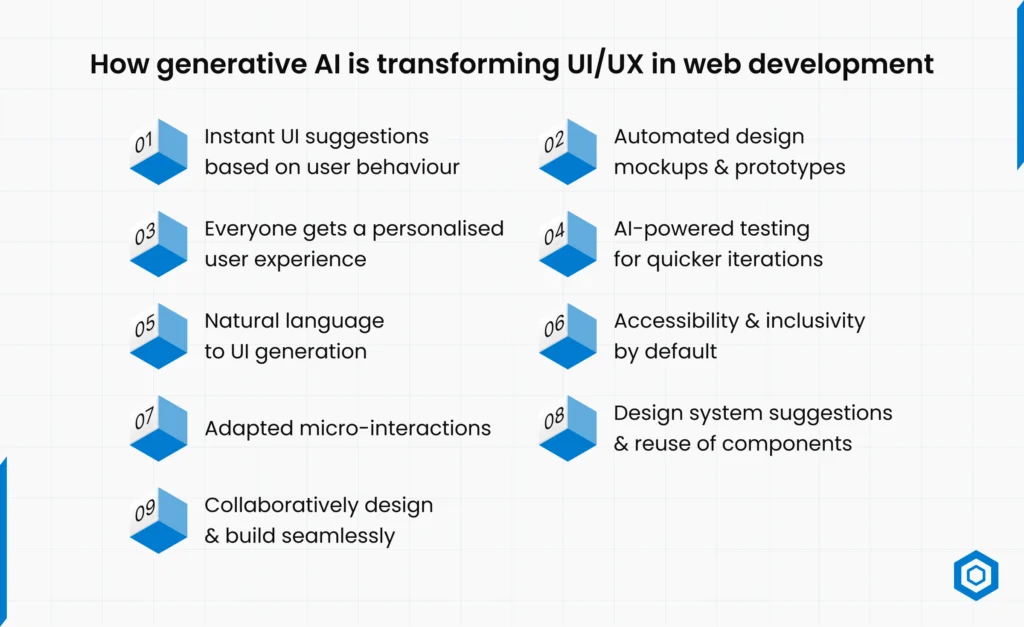
How generative AI is transforming UI UX in web development
Here are the roles of AI in user experience optimization for websites or application development:
- Instant UI Suggestions Based on User Behaviour
Generative AI can learn patterns in user interaction and immediately suggest layouts, components, and flows within their apps. It can utilise session data to learn how to continuously improve the screen elements and their context, thereby engaging the user more effectively.
Designers no longer need to rely on static wireframes. AI will adjust its suggestions based on the way a user interacts with the app or website.
- Automated Design Mockups & Prototypes
You may have heard about automated website design AI prototyping with Uizard and Galileo AI, and the potential modelling of functional UI screens from fuzzy text prompts or rough sketches. These sorts of tools save a tremendous amount of time in a fairly time-consuming form of prototyping, which can reduce stakeholder feedback cycles.
Additionally, it allows you to view multiple design iterations simultaneously, which saves you time and effort while designing.
- Everyone gets a personalised user experience.
AI-powered UI/UX design technology enables businesses to provide each user with a unique experience adapted to their location, past activities, preferences, and behaviour data.
For instance, eCommerce apps can automatically change the content, calls to action, and menu layouts on their home pages to boost sales and keep customers. This means you no longer need to do A/B testing.
- AI-powered testing for quicker iterations
Generative AI can model thousands of possible user journeys to test calls to action, navigation flows, and design elements. When viewed in the context of traditional usability testing, you will effectively uncover Blockages and Points of Friction in apps.
Designers will be able to iterate many times from trustworthy AI intelligence, i.e., not based on some unclear guesses or “test with 4 or 5 people.”
- Natural Language to UI Generation
Using natural language to describe any screen or feature, AI tools can produce pixel-perfect UI layouts. This reduces creative blocks and accelerates collaboration between design and development teams. Tools like Locofy and Penpot AI are enabling startups and enterprises to increase accessibility to this feature.
- Accessibility & Inclusivity by Default
Generative AI supports the goal of accessibility of digital products for users of all abilities through automated contrast alerts and suggestions for screen-reader-friendly content structures, as well as suggested layouts for the assistive technology.
Therefore, it provides reasonable design solutions for everyone, aligning with accessibility standards worldwide.
- Adapted Micro-Interactions
AI can also facilitate micro-interactions. Animated icons/buttons can be made to respond to hover states or scroll-animated transitions, and AI can tailor these micro-interactions to user choices and past behaviours, thus increasing the perceived level of responsiveness and fun in the user journey.
- Design System Suggestions & Reuse of Components
AI tools suggest reusable design components and keep assets consistent by platform and screen. It follows brand design systems and avoids duplication of work, an essential edge for enterprise-scale design teams.
- Collaboratively Design and Build Seamlessly
AI-enhanced protocols can connect design prototypes to actual code that is being developed. AI tools, such as Figma’s AI plugins and Framer AI, help developers achieve real design development logic by generating actual AI layouts or prototypes.
Benefits of AI-powered UI UX design for apps and web development
- Swift, Speedy Cut Costs in the Design Process
The conventional UI/UX process is usually an iterative loop. With generative AI UX tools, the number of iterations is reduced since the generative AI will generate multiple design options in seconds. This provides a significant productivity increase to startups and enterprises that are constrained by time in their MVP rollouts.
- Enhanced User Experience Through Personalisation
Generative AI enables hyper-personalisation. AI captures the user’s behaviour and modifies interfaces dynamically or even in real time.
For example, music apps or financial apps can adjust different styles of data visualisation (or other component types) on dashboards based on the user’s behaviour, improving usability and, ultimately, retention.
- Design consistency and less human error
Sometimes a design element doesn’t make it through, like brand colours, fonts, or space. AI-driven user interfaces will ensure consistency, making it look the same across all pages and platforms. Design list checks will be time-consuming for designers.
- Decisions Made on Data
This process is fuelled by heatmaps, predictive behavioural analysis, and A/B testing insights via AI tools, which in turn help in decision-making. Its effect is on elegance, and this way, you get more user engagement and conversion functionalities.
- Cost Benefits in the Development Lifecycle
Generative AI makes design and development work less costly overall by reducing design cycles and the number of design iterations. Making generative AI an interesting investment opportunity for investors, whether they are a small tech startup or a big company.
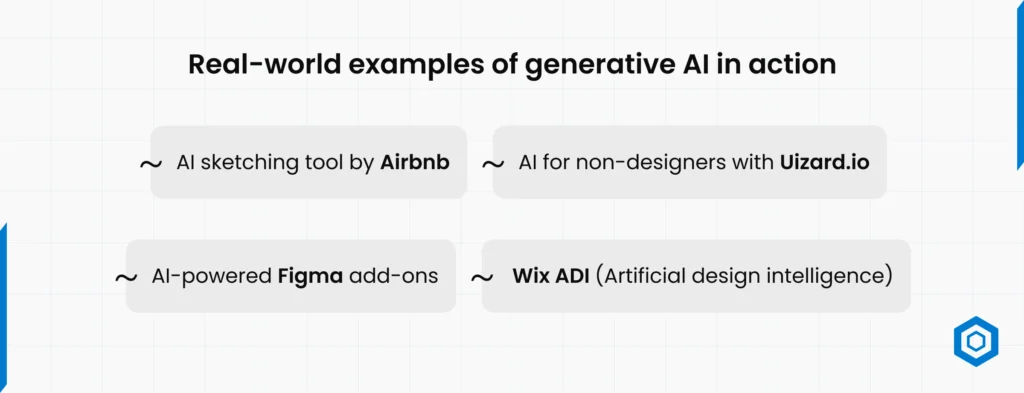
Real-World Examples of Generative AI in Action
Let’s examine a few real-world examples to get a better idea of how generative AI affects UI/UX design:
- AI Sketching Tool by Airbnb
Airbnb has built an AI tool that can use hand-drawn wireframes and automatically turn them into code. This narrowed the gap between design and prototype, making ideation faster. It exemplifies how AI-based UX design tools can simplify complex tasks.
- AI for non-designers with Uizard.io
Users can create artificial intelligence app design mockups with Uizard by either drawing basic images or typing natural language. Uizard offers a set of AI-driven mobile app UI design examples for individuals and startups lacking a dedicated design team.
- AI-Powered Figma Add-ons
New Figma plugins for digital product design that AI drives can write, copy, and suggest layouts. Not only do these plugins enable faster communication and iteration collaboration between developers and designers, but they also enhance the overall development experience.
- Wix ADI (Artificial Design Intelligence)
Wix’s ADI is an excellent example of AI creating a website without any human assistance. After asking questions, the tool will design a unique website layout according to the user’s goals and business type.
Conclusion
Generative AI is permanently changing UX/UI design. Businesses are using generative AI-based UI/UX design tools to create unique, approachable, and practical digital experiences.
More broadly, generative AI can assist you with monotonous tasks, generate concepts that combine your prior knowledge, and provide data-driven ideas that foster your creativity.
AI is making webpages and apps easier to use. Both startups and enterprises should dedicate effort to exploring generative AI tools for web designers to streamline the designers’ workflows and continue to lead the creative curve of design innovation. Hire UI/UX developer from Codeflash Infotech to get the best UI UX design for your website or apps.
As tools and user interfaces built with AI evolve, the way designers think about and interact with machine learning processes will continue to grow as well and, in turn, affect how we design and think about each digital experience.

Frequently Asked Questions
Startups can accelerate the development of their Artificial Intelligence app design by focusing on providing users with a seamless experience and complete user flows, including wireframes for illustration, without the need to hire expensive developers or designers. The startup can sell its product using this method.
Tools like Uizard, Figma AI plugins, Adobe Sensei, and Wix ADI are leading platforms using AI in digital product design to assist designers in automating design decisions and speeding up processes.
AI enhances human creativity, not replaces it. Designers still make key creative and strategic decisions, but AI helps to automate time-consuming tasks and makes astute suggestions.
Companies should first look for repetitive or data-driven design work and test “AI-powered UI UX design” tools that can support those types of tasks. Gradually expand ownership based on results and your team’s level of comfort with the adaptations made.



